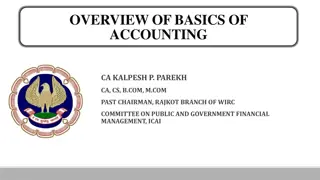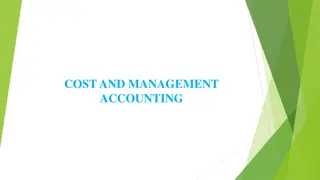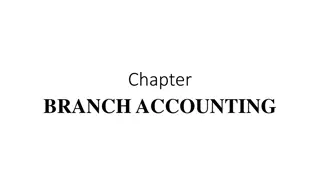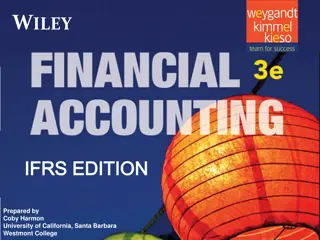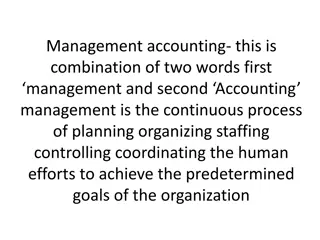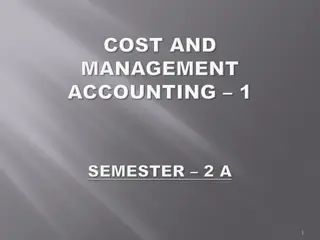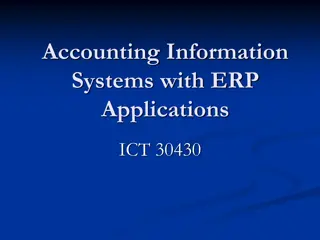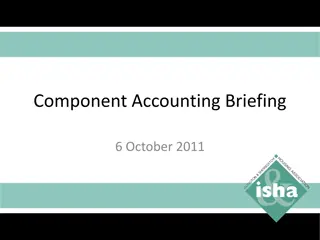Importance of Accounting in Business Operations
An accounting system plays a crucial role in providing information about a business's profitability. For sole traders, preparing a Trading and Profit and Loss Account along with a Balance Sheet helps depict the financial status. The process of finalizing accounts involves steps like Trading Account, Profit and Loss Account, and Balance Sheet. Additionally, the Profitability Statement summarizes business activities, while the Balance Sheet shows resources and funding. The Trading Account is crucial for evaluating business efficiency by determining gross profit or loss.
Download Presentation

Please find below an Image/Link to download the presentation.
The content on the website is provided AS IS for your information and personal use only. It may not be sold, licensed, or shared on other websites without obtaining consent from the author.If you encounter any issues during the download, it is possible that the publisher has removed the file from their server.
You are allowed to download the files provided on this website for personal or commercial use, subject to the condition that they are used lawfully. All files are the property of their respective owners.
The content on the website is provided AS IS for your information and personal use only. It may not be sold, licensed, or shared on other websites without obtaining consent from the author.
E N D
Presentation Transcript
The most important function of an accounting system is to provide information about the profitability of the business. A sole trader furnishes a Trading and Profit and Loss Account which depicts the result of the business transactions of the sole trader. Along with the Trading and Profit and Loss Account he also prepares a Balance Sheet which shows the financial position of the business. Steps in the Process of Finalization of Accounts A. For Trading Concerns: 1. Trading Account. 2. Profit and Loss Account. 3. Balance Sheet. B. For Manufacturing and Trading Concerns: 1. Manufacturing Account. 2. Trading Account. 3. Profit and Loss Account. 4. Balance Sheet.
Profitability Statement This statement is related to a complete accounting period. It shows the outcome of business activities during that period in a summarized form. The activities of any business will include purchase, manufacture, and sell. Balance Sheet Business needs some resources which have longer life (say more than a year). Such resources are, therefore, not related to any particular accounting period, but are to be used over the useful life thereof. The resources do not come free. One requires finance to acquire them. This funding is provided by owners through their investment, bank & other through loans, suppliers by way of credit terms. The Balance Sheet shows the list of resources and the funding of the resources i.e. assets and liabilities (towards owners and outsiders). It is also referred as sources of funds (i.e. liabilities & capital) and application of funds (i.e. assets). Let us discuss these statements in depth. Trading Account: It is an account which is prepared by a merchandising concern which purchases goods and sells the same during a particular period. The purpose of it to find out the gross profit or gross loss which is an important indicator of business efficiency.
The following items will appear in the debit side of the Trading Account: (i) Opening Stock: In case of trading concern, the opening stock means the finished goods only. The amount of opening stock should be taken from Trial Balance. (ii) Purchases: The amount of purchases made during the year. Purchases include cash as well as credit purchase. The deductions can be made from purchases, such as, purchase return, goods withdrawn by the proprietor, goods distributed as free sample etc. (iii) Direct expenses: It means all those expenses which are incurred from the time of purchases to making the goods in suitable condition. This expenses includes freight inward, octroi, wages etc. (iv) Gross profit: If the credit side of Trading A/c is greater than debit side of Trading A/c gross profit will arise.
The following items will appear in the credit side of Trading Account: (i) Sales Revenue: The sales revenue denotes income earned from the main business activity or activities. The income is earned when goods or services are sold to customers. If there is any return, it should be deducted from the sales value. As per the accrual concept, income should be recognized as soon as it is accrued and not necessarily only when the cash is paid for. The Accounting standard 7 (in case of contracting business) and Accounting standard 9 (in other cases) define the guidelines for revenue recognition. The essence of the provisions of both standards is that revenue should be recognized only when significant risks and rewards (vaguely referred to as ownership in goods) are transferred to the customer. For example, if an invoice is made for sale of goods and the term of sale is door delivery; then sale can be recognized only on getting the proof of delivery of goods at the door of customer. If such proof is pending at the end of accounting period, then this transaction cannot be taken as sales, but will be treated as unearned income. (ii) Closing Stocks: In case of trading business, there will be closing stocks of finished goods only. According to convention of conservatism, stock is valued at cost or net realizable value whichever is lower. (iii) Gross Loss: When debit side of Trading A/c is greater than credit side of Trading A/c, gross loss will appear.













